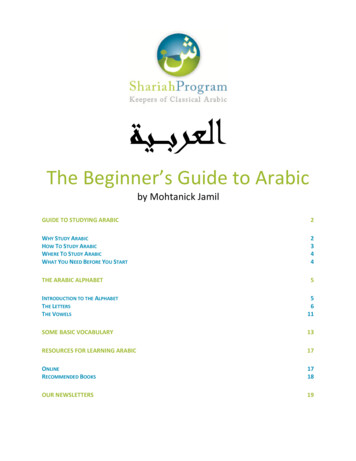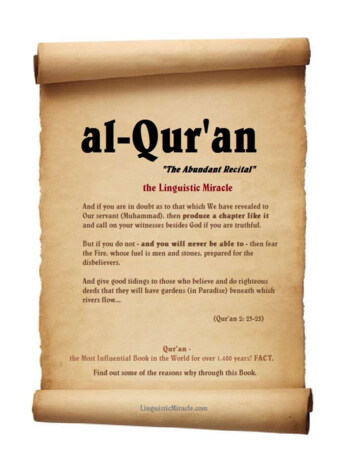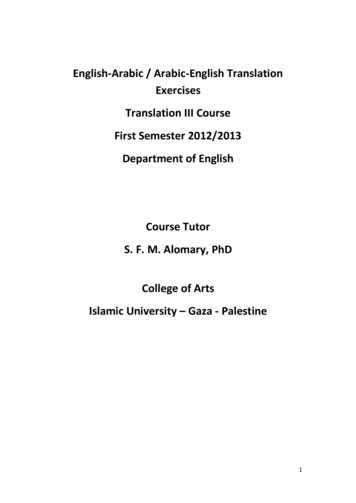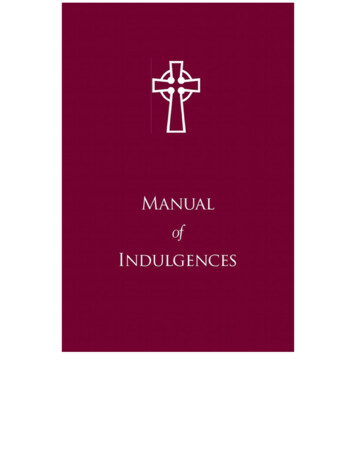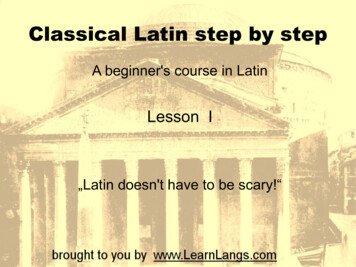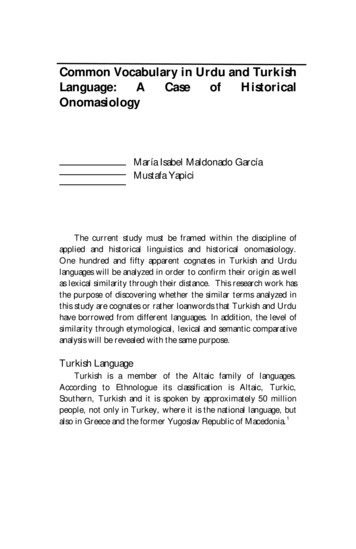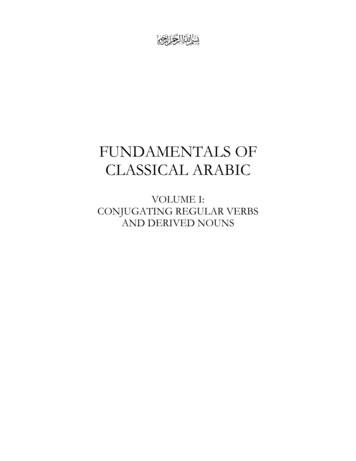
Transcription
AFUNDAMENTALS OFCLASSICAL ARABICVOLUME I:CONJUGATING REGULAR VERBSAND DERIVED NOUNS
IITo the ‘Ulamā’ of Deoband and the Mashā’ikh of Naqshband
IIIFUNDAMENTALS OFCLASSICAL ARABICVOLUME I:CONJUGATING REGULAR VERBSAND DERIVED NOUNSHUSAIN ABDUL SATTARSACRED LEARNINGCHICAGO
IV Sacred Learning 2002First Edition December 2012All rights reserved. Aside from fair use, meaning a few pages or less for non-profiteducation purposes, review, or scholarly citation, no part of this publication may bereproduced, stored in a retrieval system, or transmitted in any form or by any means,electronic, mechanical, photocopying, recording, or otherwise, without the priorpermission of the copyright owner.ISBN 0-9712761-1-0Published by:Sacred LearningChicago, orgPrinted and bound in the United States of America on premium acid-free paper. Thepaper used in this book meets the minimum requirement of ANSI/NISO Z39.481992 (R 1997) (Permanence of Paper). The binding material has been chosen forstrength and durability.
CONTENTSPrologue7Lesson 1Mapping the Arabic Language9Lesson 2Introducing Arabic Words13Lesson 3The Past Tense Verb [ ]ﹶﺍ ﹾﻟ ِﻔﻌْﻞ ﹶﺍﹾﻟﻤَﺎﺿِﻲ 17Lesson 4The Present Tense Verb [ ]ﹶﺍﹾﻟ ِﻔﻌْﻞ ﹶﺍﹾﻟﻤُﻀَﺎﺭﹺﻉ 23Lesson 5The Present Tense Verb in the State of Rafa’ [ ] َﺭﻓﹾﻊ 29Lesson 6The Present Tense Verb in the State of Nasb [ ]َﻧﺼْﺐ 33Lesson 7َ]The Present Tense Verb in the State of Jazm [ ﺟﺰْﻡ 37Lesson 8ِ ]ﺍﹶﻟﺘﱠ ﹾﺄ The Emphatic [ ﻛﻴْﺪ 41Lesson 9َ ]ﹶﺍ The Command [ ﻷﻣْﺮ 43Lesson 10The Prohibition [ ]ﺍﹶﻟﻨﱠﻬْﻲ 49Lesson 11The Active Participle [ ]ِﺍﺳْﻢ ﹶﺍﻟﹾﻔﹶﺎﻋِﻞ 53Lesson 12The Passive Participle [ ]ِﺍﺳْﻢ ﹶﺍﹾﻟ َﻤ ﹾﻔ ُﻌﻮْﻝ 61Lesson 13The Noun of Time and Place [ ]ِﺍﺳْﻢ ﺍﹶﻟﻈﱠﺮْﻑ 65Lesson 14The Noun of Usage [ ]ِﺍﺳْﻢ ﺍﻵﻟﹶﺔ 69Lesson 15ِ ]ِﺍﺳْﻢ ﺍﹶﻟﺘﱠ ﹾﻔ The Superlative Noun [ ﻀﻴْﻞ 71Lesson 16The Six Types of Verb Form I75Appendices85
VIIPrologueAll praise is due to Allah u, Creator of the universe. Peace andblessings be upon His final and noble messenger, Muhammad s.Traditionally students of sacred knowledge began by learning the tenetsof Arabic verb conjugation. Each independent lesson was masteredbefore a teacher allowed students to advance. Once proficient, studentsthen focused on the principles of Arabic grammar.I was blessed to attend a school of religious learning in Pakistan that stillemploys traditional methods. My instructors studied under sincereteachers and carried themselves with similar devotion. Furthermore, theyled their students, step by step, along a trail softened by fourteenhundred years of scholarship. Although I was able to spend only a fewyears in the company of such guides, my progress was rapid. Such is thefortune of the debris that manages to land itself on a rapidly flowing,pristine river.Few Arabic textbooks in English are modeled after traditional Islamiceducational methodologies. In this book, I have combined the notes andresources used by my teachers to present an overview of Arabic verband noun conjugation. Insha’llah (God willing), future volumes willaddress other principles of classical Arabic grammar.My fear in compiling this work is that I have soiled a pure chain. Myteachers sacrificed their lives, wealth, and families to achieve perfectionin their respective fields. I was permitted to sit in, and eat from, theirvast gardens despite my obvious deficiencies and lack of commitment.This is the mercy of a teacher toward his student. I pray that Allah uoverlooks this last link and allows the seeker to benefit from the
8FUNDAMENTALS OF CLASSICAL ARABICdevotion of the great scholars of the past. Please pray for me, myteachers, and all those who transmitted this tradition from onegeneration to the next.A servant of the scholarsHusain Abdul SattarSafar 1423 – April 2002
Lesson One: Mapping the Arabic LanguageFigure 1.1 presents a map of the Arabic language. This chart provides anoverview of the task at hand and establishes a framework for futurelearning.PRINCIPLE ONEThe term articulation ( )ﹶﻟﻔﹶﻆ 1 refers to all words that are produced by thetongue. Articulations ( )ﹶﻟﻔﹶﻆ are divided into (1) words that are meaningfulُ ) َﻣ ْﻮ and (2) words that are meaningless ( ) ُﻣ ْﻬﻤَﻞ . Meaningful ( ﺿﻮْﻉ ُ ) َﻣ ْﻮ ( ﺿﻮْﻉ articulations have established, understood meanings. For example, theArabic word kitab( ) ِﻛﺘَﺎﺏ means, “a book.” On the other hand,meaningless ( ) ُﻣ ْﻬﻤَﻞ articulations lack established meanings. Consider, forexample, the word “Pepsi.” If articulated five hundred years ago, beforethe advent of this now famous beverage, this word would have had nomeaning.PRINCIPLE TWOMeaningful ( ﺿﻮْﻉ ُ ) َﻣ ْﻮ articulations can be further divided into (1) single( ) ُﻣ ﹾﻔﺮَﺩ and (2) compound ( ) ُﻣ َﺮﻛﱠﺐ . If an articulation is composed of one( ;) ُﻣ ﹾﻔﺮَﺩ whereas, if it is composed of more thanone word, it is called compound ( ) ُﻣ َﺮﻛﱠﺐ . For example, the word kitabِ ) is single ( ) ُﻣ ﹾﻔﺮَﺩ , while the phrase rasul-Allah ( ) َﺭﺳُ ْﻮﻝﹸ ﺍﷲ , 2 made up of( ﻛﺘَﺎﺏ two words, is compound ( ) ُﻣ َﺮﻛﱠﺐ .word, it is called single1Lafad ( )ﹶﻟﻔﹶﻆ is derived from the verbal noun “to throw.” Arabic grammarians use this term torefer to articulations because speech involves “throwing” sounds from the tongue.2 َﺭﺳُ ْﻮﻝﹸ ﺍﷲ means, “Messenger of Allah.”
FUNDAMENTALS OF CLASSICAL ARABIC10PRINCIPLE THREEAll single ( ) ُﻣ ﹾﻔﺮَﺩ words are classified into one of three types:1) noun ( )ِﺍﺳْﻢ 2) verb ( ) ِﻓﻌْﻞ َ)3) particle ( ﺣﺮْﻑ Stated otherwise, every word in the Arabic dictionary fits into one ofthese three categories.PRINCIPLE FOURCompound ( ) ُﻣ َﺮﻛﱠﺐ articulations are made up of two or more words. Suchcombinations are either beneficial ( ) ُﻣ ِﻔﻴْﺪ or non-beneficial ( ) ﹶﻏﻴْﺮ ُﻣ ِﻔﻴْﺪ . Beneficial( ) ُﻣ ِﻔﻴْﺪ groups of words express a complete idea and join together to forma complete sentence. Non-beneficial ( ) ﹶﻏﻴْﺮ ُﻣ ِﻔﻴْﺪ groups of words express anincomplete idea and join together to form a phrase, 3 or an incompletesentence.This volume deals with single ( ) ُﻣ ﹾﻔﺮَﺩ words and emphasizes conjugatingverbs and derived nouns.3A phrase is defined as two or more words that form a syntactic unit that is less than acomplete sentence.
Mapping the Arabic Language11 ﹶﻟﻔﹶﻆ Articulation ُﻣ ْﻬﻤَﻞ ﺿﻮْﻉ ُ َﻣ ْﻮ MeaninglessMeaningful ُﻣ َﺮﻛﱠﺐ ُﻣ ﹾﻔﺮَﺩ Compound ُﻣ ِﻔﻴْﺪ Single ِﺍ ْﺳﻢ BeneficialNoun ﹶﻏﻴْﺮ ُﻣ ِﻔﻴْﺪ ِﻓﻌْﻞ Non-beneficialVerb َﺣﺮْﻑ ParticleFIGURE 1.1A MAP OF THE ARABIC LANGUAGE
Lesson Two: Introducing Arabic WordsPRINCIPLE ONEThe Arabic alphabet consists of twenty-nine letters and three shortvowels (figure 2.1). This text assumes that the reader is familiar with thealphabet and its short vowels.PRINCIPLE TWOMost Arabic words are formed from three base letters. These threeletters join together to establish a meaning. For example, the base letters ﺏ - ﺕ - ( ﻙ read from right to left) express the meaning of “to write.”PRINCIPLE THREE ﻝ - ﻉ - ﻑ are used as model base letters. 4 The first letter iscalled the “fā’ ( ) ﻑ position.” The second is called the “‘ain ( ) ﻉ position.” The third is called the “lām ( ) ﻝ position.” The base letters ﻝ - ﻉ - ﻑ express the meaning of “to do.”The lettersPRINCIPLE FOURMost Arabic nouns and verbs are derived by placing the three baseletters on designated patterns. These patterns involve voweling5 the baseletters and often require the addition of non-base letters. Each of thesepatterns reflects the meaning of the base letters in a unique way. Forexample, the pattern ﻓﹶﺎﻋِﻞ describes a person who enacts the meaning ofthe base letters.6 This pattern involves voweling the fā’ ( ) ﻑ position4The letters ﻝ - ﻉ - ﻑ are used throughout the text to illustrate verb and noun patterns.5Voweling refers to the addition of the short vowels: dammah, fathah, and kasrah.6The English language also makes use of patterns. Consider, for example, the word “teacher.”Adding the suffix “er” to the verb teach produces the word “teacher.” This pattern describes aperson who enacts the meaning of the verb (i.e., one who teaches). Similarly, consideradditional English words that follow this pattern, such as “builder” (one who builds) and“thinker” (one who thinks).
14FUNDAMENTALS OF CLASSICAL ARABIC ) ﻉ position with akasrah. If the base letters ﺏ - ﺕ - ( ﻙ to write) replace the fā’ ( ) ﻑ , ‘ain( ) ﻉ , and lām ( ) ﻝ positions in this pattern, the word ( ﻛﹶﺎﺗِﺐ one whowrites) is formed (figure 2.2). Similarly, replacing the fā’ ( ) ﻑ , ‘ain ( ) ﻉ ,and lām ( ) ﻝ positions with the base letters ﺩ - ﺏ - ( ﻉ to worship) formsthe word ( ﻋَﺎﺑﹺﺪ one who worships).with a fathah, adding an ‘alif, and voweling the ‘ain (
Introducing Arabic Words15THE ARABIC ALPHABET ﺝ ﺙ ﺕ ﺏ ﺍ JĪMTHĀ’TĀ’BĀ’‘ALIF ﺭ ﺫ ﺩ ﺥ ﺡ RĀ’DHĀLDĀLKHĀ’HĀ’ ﺽ ﺹ ﺵ ﺱ ﺯ DHĀDSĀDSHĪNSĪNZĀ’ ﻑ ﻍ ﻉ ﻅ ﻁ FĀ’GHAIN‘AINZHĀ’THĀ’ ﻥ ﻡ ﻝ ﻙ ﻕ NŪNMĪMLĀMKĀFQĀF ﺀ ﻯ ﻭ ه HAMZAHYĀ’WĀWHĀ’NTHE ARABIC SHORT VOWELSِKASRAHَFATHAHُDAMMAHFIGURE 2.1THE ARABIC ALPHABET AND ITS SHORT VOWELS
16FUNDAMENTALS OF CLASSICAL ARABIC ﻓﹶﺎﻋِﻞ ONE WHO DOESStep One: Separate the lettersof the pattern ﻉ ﻝ ﻑ ﺍ ﹺ َStep Two: Replace the base letters ( ﻝ - ﻉ - )ﻑ with corresponding new letters ( ﺏ - ﺕ - )ﻙ ﺕ ﺏ ِ َﻙ ﺍ Step Three: Reattach the lettersto form the new word ﻛﹶﺎﺗِﺐ ONE WHO WRITES or A WRITERFIGURE 2.2FORMING WORDS FROM BASE LETTERS
Lesson Three: The Past Tense Verb[ ]ﹶﺍﹾﻟ ِﻔﻌْﻞ ﹶﺍﹾﻟﻤَﺎﺿِﻲ The past tense verb ( ﹶﺍﹾﻟﻤَﺎﺿِﻲ )ﹶﺍﹾﻟ ِﻔﻌْﻞ describes actions or events that havealready occurred.PRINCIPLE ONEThe pattern ( ﹶﻓ َﻌ ﹶﻞ he did) is used as a model for the past tense verb. In thispattern each of the base letters is voweled with a fathah.7PRINCIPLE TWOVerbs in the English language are conjugated to reflect the subject8 ofthe verb. For example, “he did” and “we did.” Here, the pronouns “he”and “we” indicate the subject. Arabic verbs are conjugated in a similarmanner. In particular, the Arabic verb is conjugated to reflect threeaspects of its subject:1) person9 (first, second, third)2) gender10 (masculine, feminine)3) plurality11 (singular, dual, plural)7The pattern ﻞ ﹶﻓ َﻌ ﹶ is one of several patterns used for the past tense verb. Others are presented inLesson Sixteen.8The subject denotes the doer of the action described by a verb.9The first person is used to refer to the speaker. For example, “I did” or “we did.” The secondperson is used to refer to the individual spoken to. For example, “you did.” The third person isused to refer to the individual spoken of. For example, “he did” or “they did.”10The masculine is used to refer to male beings or masculine objects. For example, “he did” or “itdid.” The feminine is used to refer to female beings or feminine objects. For example, “she did” or“it did.”11The singular is used to refer to an individual. For example, “he did.” The dual is used to referto two individuals. For example, “both of them did.” The plural is used to refer to a group. Forexample, “they did.”
FUNDAMENTALS OF CLASSICAL ARABIC18PRINCIPLE THREEWhile English verbs are conjugated by placing a noun or pronounbefore the verb, Arabic verbs are conjugated by adding designated lettersto the end of the verb. Carefully study the past tense verb conjugations(table 3.1), noting the changes in person, gender, and plurality.PRINCIPLE FOUREnglish verbs may express either the active or the passive voice. Theactive voice is used when the subject of the sentence performs the actionexpressed by the verb. For example, “Zaid wrote a book.” Here, theverb “wrote” is in the active voice because Zaid is indicated as thewriter. The passive voice, on the other hand, is used when the subject ofthe verb is not indicated. For example, “A book was written.” Here, theverb “was written” is in the passive voice because, although a book waswritten, the writer is not indicated.Arabic verbs also express either the active or the passive voice. Earlier,principle one illustrated ﹶﻓ َﻌ ﹶﻞ as a model for the active voice of the past tenseverb. The pattern for the passive voice of the past tense verb is formed fromthe active voice by (1) changing the voweling of the first letter to adammah and (2) changing the voweling of the second to last letter to a ( ﹶﻓ َﻌ ﹶ he did) becomes ( ﻓﹸ ِﻌ ﹶﻞ it was done).kasrah. Thus ﻞ PRINCIPLE FIVEPrinciple two established that verbs in the active voice are conjugated toreflect the subject of the verb. When conjugating verbs in the passivevoice, each conjugation reflects the person, gender, and plurality of theobject, 12 and not the subject, of the verb. For example, consider thestatement ﺏ َ ( ﺿُ ﹺﺮ he was hit). Here, the object of the verb is stated (i.e.,he), but the subject is not indicated. Therefore, the verb is conjugated to12The object denotes the noun that receives the action of a verb.
The Past Tense Verb19reflect the object of the verb. As illustrated in table 3.2, active and passivevoice conjugations use the same endings.PRINCIPLE SIXPlacing the word “ ” ﻣَﺎ before both the active and passive voice negates ( ﹶﻓ َﻌ ﹶﻞ he did) becomes ( ﻣَﺎ ﹶﻓ َﻌ ﹶﻞ he ( ﻓﹸ ِﻌ ﹶ it was done) becomes ( ﻣَﺎ ﻓﹸ ِﻌ ﹶﻞ it was not done).did not do), and ﻞ the past tense verb (table 3.2). For example,ESSENTIAL NOTEThe conjugations of the past tense verb must be memorized (table 3.2)before moving to the next lesson.
FUNDAMENTALS OF CLASSICAL ARABIC20TABLE 3.1CONJUGATING THE PAST TENSE VERBPERSONGENDERPLURALITYBASE3rdMasculineSingular ﻓﻌﻞ 3rd3rd3rd3rd3rd2nd2nd2nd2nd2nd2nd1st1stM nineMasculine andFeminineMasculine lPluralSingularDualPluralSingularPluralF FeminineACTIVEVOICESUFFIXHe/It (S/M) did ﻓﻌﻞ ﺍ ﻓﻌﻞ ﻭْﺍ ﻓﻌﻞ ﺕ ْ ﻓﻌﻞ ﺗَﺎ ﻓﻌﻞ ﹶﻥ ﻓﻌﻞ ﺕ َ ﻓﻌﻞ ُﺗﻤَﺎ ﻓﻌﻞ ُﺗ ْﻢ ﻓﻌﻞ ﺕ ِ ﻓﻌﻞ ُﺗﻤَﺎ ﻓﻌﻞ ُﺗﻦﱠ ﻓﻌﻞ ﺕ ُ ﻓﻌﻞ ﻧَﺎ S SingularThe ‘alif ( ) ﺍ at the end of this conjugation is not pronounced. ﹶﻓ َﻌ ﹶﻞ D Dual ﻼ ﹶﻓ َﻌ ﹶ They (D/M) did13 ﹶﻓ َﻌﹸﻠﻮْﺍ They (P/M) did ﺖ ْ ﹶﻓ َﻌﹶﻠ She/It (S/F) did ﹶﻓ َﻌﹶﻠﺘَﺎ They (D/F) did ﹶﻓ َﻌ ﹾﻠ َﻦ They (P/F) did ﺖ َ ﹶﻓ َﻌ ﹾﻠ You (S/M) did ﹶﻓ َﻌ ﹾﻠُﺘﻤَﺎ You (D/M) did ﹶﻓ َﻌ ﹾﻠُﺘ ْﻢ You (P/M) did ﺖ ِ ﹶﻓ َﻌ ﹾﻠ You (S/F) did ﹶﻓ َﻌ ﹾﻠُﺘﻤَﺎ You (D/F) did ﹶﻓ َﻌ ﹾﻠﺘُ ﱠﻦ You (P/F) didُ ﹶﻓ َﻌ ﹾﻠﺖ I did ﹶﻓ َﻌ ﹾﻠﻨَﺎ We didP Plural
The Past Tense Verb21TABLE 3.2THE PAST TENSE VERBPASSIVE VOICENEGATIONACTIVE VOICENEGATIONPASSIVE VOICEACTIVE VOICE ﻣَﺎ ﻓﹸ ِﻌ ﹶﻞ ﻣَﺎ ﹶﻓ َﻌ ﹶﻞ ﻓﹸ ِﻌ ﹶﻞ ﹶﻓ َﻌ ﹶﻞ He/It (S/M) was not doneHe/It (S/M) did not doHe/It (S/M) was doneHe/It (S/M) did ﻼ ﻣَﺎ ﻓﹸ ِﻌ ﹶ ﻼ ﻣَﺎ ﹶﻓ َﻌ ﹶ ﻼ ﻓﹸ ِﻌ ﹶ ﻼ ﹶﻓ َﻌ ﹶ They (D/M) were not doneThey (D/M) did not doThey (D/M) were doneThey (D/M) did ﻣَﺎ ﹸﻓ ِﻌﹸﻠﻮْﺍ ﻣَﺎ ﹶﻓ َﻌﹸﻠﻮْﺍ ﹸﻓ ِﻌﹸﻠﻮْﺍ ﹶﻓ َﻌﹸﻠﻮْﺍ They (P/M) were not doneThey (P/M) did not do ﺖ ْ ﻣَﺎ ﻓﹸ ِﻌﹶﻠ ﺖ ْ ﻣَﺎ ﹶﻓ َﻌﹶﻠ ﺖ ْ ﻓﹸ ِﻌﹶﻠ ﺖ ْ ﹶﻓ َﻌﹶﻠ She/It (S/F) was not doneShe/It (S/F) did not doShe/It (S/F) was doneShe/It (S/F) did ﻣَﺎ ﹸﻓ ِﻌﹶﻠﺘَﺎ ﻣَﺎ ﹶﻓ َﻌﹶﻠﺘَﺎ ﹸﻓ ِﻌﹶﻠﺘَﺎ ﹶﻓ َﻌﹶﻠﺘَﺎ They (D/F) were not doneThey (D/F) did not doThey (D/F) were doneThey (D/F) did ﻣَﺎ ﻓﹸ ِﻌ ﹾﻠ َﻦ ﻣَﺎ ﹶﻓ َﻌ ﹾﻠ َﻦ ﻓﹸ ِﻌ ﹾﻠ َﻦ ﹶﻓ َﻌ ﹾﻠ َﻦ They (P/F) were not doneThey (P/F) did not doThey (P/F) were doneThey (P/F) did ﺖ َ ﻣَﺎ ﻓﹸ ِﻌ ﹾﻠ ﺖ َ ﻣَﺎ ﹶﻓ َﻌ ﹾﻠ ﺖ َ ﻓﹸ ِﻌ ﹾﻠ ﺖ َ ﹶﻓ َﻌ ﹾﻠ You (S/M) were not doneYou (S/M) did not doYou (S/M) were doneYou (S/M) did ﻣَﺎ ﹸﻓ ِﻌ ﹾﻠُﺘﻤَﺎ ﻣَﺎ ﹶﻓ َﻌ ﹾﻠُﺘﻤَﺎ ﹸﻓ ِﻌ ﹾﻠُﺘﻤَﺎ ﹶﻓ َﻌ ﹾﻠُﺘﻤَﺎ You (D/M) were not doneYou (D/M) did not doYou (D/M) were doneYou (D/M) didThey (P/M) did ﻣَﺎ ﹸﻓ ِﻌ ﹾﻠُﺘ ْﻢ ﻣَﺎ ﹶﻓ َﻌ ﹾﻠُﺘ ْﻢ ﹸﻓ ِﻌ ﹾﻠُﺘ ْﻢ ﹶﻓ َﻌ ﹾﻠُﺘ ْﻢ You (P/M) were not doneYou (P/M) did not doYou (P/M) were doneYou (P/M) did ﺖ ِ ﻣَﺎ ﻓﹸ ِﻌ ﹾﻠ ﺖ ِ ﻣَﺎ ﹶﻓ َﻌ ﹾﻠ ﺖ ِ ﻓﹸ ِﻌ ﹾﻠ ﺖ ِ ﹶﻓ َﻌ ﹾﻠ You (S/F) did not doYou (S/F) were doneYou (S/F) did ﻣَﺎ ﹸﻓ ِﻌ ﹾﻠُﺘﻤَﺎ ﻣَﺎ ﹶﻓ َﻌ ﹾﻠُﺘﻤَﺎ ﹸﻓ ِﻌ ﹾﻠُﺘﻤَﺎ ﹶﻓ َﻌ ﹾﻠُﺘﻤَﺎ You (D/F) were not doneYou (D/F) did not doYou (D/F) were doneYou (D/F) did ﻣَﺎ ﹸﻓ ِﻌ ﹾﻠُﺘﻦﱠ ﻣَﺎ ﹶﻓ َﻌ ﹾﻠﺘُ ﱠﻦ ﹸﻓ ِﻌ ﹾﻠُﺘﻦﱠ ﹶﻓ َﻌ ﹾﻠﺘُ ﱠﻦ You (P/F) were not doneYou (P/F) did not doYou (P/F) were doneYou (P/F) didُ ﻣَﺎ ﻓﹸ ِﻌ ﹾﻠﺖ ُ ﻣَﺎ ﹶﻓ َﻌ ﹾﻠﺖ ُ ﻓﹸ ِﻌ ﹾﻠﺖ ُ ﹶﻓ َﻌ ﹾﻠﺖ I was not doneI did not doI was doneI did ﻣَﺎ ﹸﻓ ِﻌ ﹾﻠﻨَﺎ ﻣَﺎ ﹶﻓ َﻌ ﹾﻠﻨَﺎ ﹸﻓ ِﻌ ﹾﻠﻨَﺎ ﹶﻓ َﻌ ﹾﻠﻨَﺎ You (S/F) were not doneWe were not doneM Masculine14They (P/M) weredone14We did not doF FeminineWe were doneS SingularD DualWe didP Plural“They were done,” implies several acts were performed. Recall that the passive verb isconjugated to reflect its object.
Lesson Four: The Present Tense Verb[ ]ﹶﺍﹾﻟ ِﻔﻌْﻞ ﹶﺍﹾﻟﻤُﻀَﺎﺭﹺﻉ The present tense verb ( ﹶﺍﹾﻟﻤُﻀَﺎﺭﹺﻉ )ﹶﺍﹾﻟ ِﻔﻌْﻞ describes actions or events that areongoing.15 Present tense verbs are conjugated using prefixes and suffixes.PRINCIPLE ONEThe pattern ( َﻳ ﹾﻔ َﻌﻞﹸ he does) is used as a model for the active voice of thepresent tense verb. Depending on the particular conjugation, one of fourletters (yā’, tā’, nūn, or hamzah) is always prefixed to the three base letters(table 4.1).PRINCIPLE TWOThe active voice of the present tense verb is conjugated by addingdesignated letters to the end of the verb. Like the past tense, theseconjugations reflect three aspects of the verb’s subject: person, gender,and plurality. Carefully study table 4.1, noting the differences between thevarious conjugations.PRINCIPLE THREEThe present tense verb may express either the active or the passive voice.The pattern for the passive voice of the present tense verb is formed fromthe active voice by (1) changing the voweling of the first letter to adammah and (2) changing the voweling of the second to last letter to afathah.16 Thus ( َﻳ ﹾﻔ َﻌﻞﹸ he does) becomes ( ﻳُ ﹾﻔ َﻌﻞﹸ it is being done).15The present tense verb includes both the continuous present tense (e.g., he is doing) and thehabitual present tense (e.g., he does).16This second step is only necessary if the active voice of the present tense verb has a dammah or akasrah on its second to last letter. Such patterns are covered in Lesson Sixteen.
24FUNDAMENTALS OF CLASSICAL ARABICPRINCIPLE FOURThe designated suffixes used for the active voice of the present tense verbare also used for the passive voice. However, the conjugations of thepassive voice reflect the person, gender, and plurality of the object, andnot the subject, of the verb. Table 4.2 illustrates both active and passiveconjugations of the present tense verb.PRINCIPLE FIVE ” ﹶﻻ before both the active and the passive voiceconjugations negates the present tense verb (table 4.2). For example, ( َﻳ ﹾﻔ َﻌﻞﹸ he ( ﹶ he does not do), and ( ﻳُ ﹾﻔ َﻌﻞﹸ it is being done) becomesdoes) becomes ﻻ َﻳ ﹾﻔ َﻌﻞﹸ ( ﹶﻻ ﻳُ ﹾﻔ َﻌﻞﹸ it is not being done).Placing the word “PRINCIPLE SIXThe present tense verb may also describe a future event or action. 17 Forexample, َﻳ ﹾﻔ َﻌﻞﹸ may be translated as, “he will do.” Placing either the letterَ ” or the word “ ﻑ َ ” َﺳ ْﻮ before active and passive voice conjugations“ ﺱ of the present tense verb explicitly indicates future meaning (table 4.3). Forَ and ﻑ َﻳ ﹾﻔ َﻌﻞﹸ َ َﺳ ْﻮ are both translated as, “he will do.”example, ﺳَﻴ ﹾﻔ َﻌﻞﹸ ESSENTIAL NOTEThe conjugations of the present tense verb must be memorized (table 4.2)before moving to the next lesson.17Throughout this book, ﹶﺍﹾﻟ ِﻔﻌْﻞ ﹶﺍﹾﻟﻤُﻀَﺎﺭﹺﻉ has been translated as the “present tense verb.” Moreaccurately, however, this Arabic term refers to the imperfect tense. Imperfect implies that theactions referred to are not yet complete. Thus, it includes both the present tense, “he does,”and the future tense, “he will do.”
The Present Tense Verb25TABLE 4.1CONJUGATING THE PRESENT TENSE VERBPERSONGENDER & ineDualPluralPlural ﻓﻌﻞ ﻱ ْﻭ ﹶﻥ ﻓﻌﻞ ﻱ ﻓﻌﻞ ﺕ ﺍ ِﻥ ﻓﻌﻞ ﺕ ﹶﻥ ﻓﻌﻞ ﻱ ﻓﻌﻞ ﺕ ﻓﻌﻞ ﺕ ْﻭ ﹶﻥ ﻓﻌﻞ ﺕ ْﻳ َﻦ ﻓﻌﻞ ﺕ ﺍ ِﻥ ﻓﻌﻞ ﺕ ﹶﻥ ﻓﻌﻞ ﺕ ﺍ ِﻥ ineandFemininePluralACTIVEVOICEPREFIX ﻱ SingularDualBASE ﻓﻌﻞ SingularMasculineandFeminineM MasculineSUFFIX ﺍ ِﻥ F FeminineHe/It (S/M) does َﻳ ﹾﻔ َﻌﻠﹸ ْﻮ ﹶﻥ They (P/M) do َﺗ ﹾﻔ َﻌﻞﹸ She/It (S/F) does ﻼ ِﻥ َﺗ ﹾﻔ َﻌ ﹶ They (D/F) do َﻳ ﹾﻔ َﻌ ﹾﻠ َﻦ They (P/F) do َﺗ ﹾﻔ َﻌﻞﹸ You (S/M) do ﻼ ِﻥ َﺗ ﹾﻔ َﻌ ﹶ You (D/M) do َﺗ ﹾﻔ َﻌﻠﹸ ْﻮ ﹶﻥ You (P/M) do َﺗ ﹾﻔ َﻌِﻠْﻴ َﻦ You (S/F) do ﻼ ِﻥ َﺗ ﹾﻔ َﻌ ﹶ You (D/F) do َﺗ ﹾﻔ َﻌ ﹾﻠ َﻦ You (P/F) do ﺃ ﻓﻌﻞ ﻥ D Dual ﻼ ِﻥ َﻳ ﹾﻔ َﻌ ﹶ They (D/M) do ﻓﻌﻞ S Singular َﻳ ﹾﻔ َﻌﻞﹸ ﹶﺃ ﹾﻓ َﻌﻞﹸ I do َﻧ ﹾﻔ َﻌﻞﹸ We doP Plural
FUNDAMENTALS OF CLASSICAL ARABIC26TABLE 4.2THE PRESENT TENSE VERBPASSIVE VOICENEGATIONACTIVE VOICENEGATIONPASSIVE VOICEACTIVE VOICE ﻻ ﻳُ ﹾﻔ َﻌﻞﹸ ﻻ َﻳ ﹾﻔ َﻌﻞﹸ ﻳُ ﹾﻔ َﻌﻞﹸ َﻳ ﹾﻔ َﻌﻞﹸ He/It (S/M) is not being doneHe/It (S/M) does not doHe/It (S/M) is being doneHe/It (S/M) does ﻼ ِﻥ ﻻ ﻳُ ﹾﻔ َﻌ ﹶ ﻼ ِﻥ ﻻ َﻳ ﹾﻔ َﻌ ﹶ ﻼ ِﻥ ﻳُ ﹾﻔ َﻌ ﹶ ﻼ ِﻥ َﻳ ﹾﻔ َﻌ ﹶ They (D/M) are not being doneThey (D/M) do not doThey (D/M) are being doneThey (D/M) do ﻻ ﻳُ ﹾﻔ َﻌﻠﹸ ْﻮ ﹶﻥ ﻻ َﻳ ﹾﻔ َﻌﻠﹸ ْﻮ ﹶﻥ ﻳُ ﹾﻔ َﻌﻠﹸ ْﻮ ﹶﻥ َﻳ ﹾﻔ َﻌﻠﹸ ْﻮ ﹶﻥ They (P/M) are not being doneThey (P/M) do not doThey (P/M) are being doneThey (P/M) do ﻻ ﺗُ ﹾﻔ َﻌﻞﹸ ﻻ َﺗ ﹾﻔ َﻌﻞﹸ ﺗُ ﹾﻔ َﻌﻞﹸ َﺗ ﹾﻔ َﻌﻞﹸ She/It (S/F) is not being doneShe/It (S/F) does not doShe/It (S/F) is being doneShe/It (S/F) does ﻼ ِﻥ ﻻ ﺗُ ﹾﻔ َﻌ ﹶ ﻼ ِﻥ ﻻ َﺗ ﹾﻔ َﻌ ﹶ ﻼ ِﻥ ﺗُ ﹾﻔ َﻌ ﹶ ﻼ ِﻥ َﺗ ﹾﻔ َﻌ ﹶ They (D/F) are not being doneThey (D/F) do not doThey (D/F) are being doneThey (D/F) do ﻻ ﻳُ ﹾﻔ َﻌ ﹾﻠ َﻦ ﻻ َﻳ ﹾﻔ َﻌ ﹾﻠ َﻦ ﻳُ ﹾﻔ َﻌ ﹾﻠ َﻦ َﻳ ﹾﻔ َﻌ ﹾﻠ َﻦ They (P/F) are not being doneThey (P/F) do not doThey (P/F) are being doneThey (P/F) do ﻻ ﺗُ ﹾﻔ َﻌﻞﹸ ﻻ َﺗ ﹾﻔ َﻌﻞﹸ ﺗُ ﹾﻔ َﻌﻞﹸ َﺗ ﹾﻔ َﻌﻞﹸ You (S/M) are not being doneYou (S/M) do not doYou (S/M) are being doneYou (S/M) do ﻼ ِﻥ ﻻ ﺗُ ﹾﻔ َﻌ ﹶ ﻼ ِﻥ ﻻ َﺗ ﹾﻔ َﻌ ﹶ ﻼ ِﻥ ﺗُ ﹾﻔ َﻌ ﹶ ﻼ ِﻥ َﺗ ﹾﻔ َﻌ ﹶ You (D/M) are not being doneYou (D/M) do not doYou (D/M) are being doneYou (D/M) do ﻻ ﺗُ ﹾﻔ َﻌﻠﹸ ْﻮ ﹶﻥ ﻻ َﺗ ﹾﻔ َﻌﻠﹸ ْﻮ ﹶﻥ ﺗُ ﹾﻔ َﻌﻠﹸ ْﻮ ﹶﻥ َﺗ ﹾﻔ َﻌﻠﹸ ْﻮ ﹶﻥ You (P/M) are not being doneYou (P/M) do not doYou (P/M) are being doneYou (P/M) do ﻻ ﺗُ ﹾﻔ َﻌِﻠْﻴ َﻦ ﻻ َﺗ ﹾﻔ َﻌِﻠْﻴ َﻦ ﺗُ ﹾﻔ َﻌِﻠْﻴ َﻦ َﺗ ﹾﻔ َﻌِﻠْﻴ َﻦ You (S/F) are not being doneYou (S/F) do not doYou (S/F) are being doneYou (S/F) do ﻼ ِﻥ ﻻ ﺗُ ﹾﻔ َﻌ ﹶ ﻼ ِﻥ ﻻ َﺗ ﹾﻔ َﻌ ﹶ ﻼ ِﻥ ﺗُ ﹾﻔ َﻌ ﹶ ﻼ ِﻥ َﺗ ﹾﻔ َﻌ ﹶ You (D/F) are not being doneYou (D/F) do not doYou (D/F) are being doneYou (D/F) do ﻻ ﺗُ ﹾﻔ َﻌ ﹾﻠ َﻦ ﻻ َﺗ ﹾﻔ َﻌ ﹾﻠ َﻦ ﺗُ ﹾﻔ َﻌ ﹾﻠ َﻦ َﺗ ﹾﻔ َﻌ ﹾﻠ َﻦ You (P/F) are not being doneYou (P/F) do not doYou (P/F) are being doneYou (P/F) do ﻻ ﺃﹸ ﹾﻓ َﻌﻞﹸ ﻻ ﹶﺃ ﹾﻓ َﻌﻞﹸ ﺃﹸ ﹾﻓ َﻌﻞﹸ ﹶﺃ ﹾﻓ َﻌﻞﹸ I am not being doneI do not doI am being doneI do ﻻ ﻧُ ﹾﻔ َﻌﻞﹸ ﻻ َﻧ ﹾﻔ َﻌﻞﹸ ﻧُ ﹾﻔ َﻌﻞﹸ َﻧ ﹾﻔ َﻌﻞﹸ We are not being doneM MasculineWe do not doF FeminineWe are being doneS SingularD DualWe doP Plural
The Present Tense Verb27TABLE 4.3THE FUTURE TENSEPASSIVE VOICEFUTUREACTIVE VOICEFUTUREPASSIVE VOICEFUTUREACTIVE VOICEFUTURE ﻑ ﻳُ ﹾﻔ َﻌﻞﹸ َ َﺳ ْﻮ ﻑ َﻳ ﹾﻔ َﻌﻞﹸ َ َﺳ ْﻮ He/It (S/M) will do َﺳﻴُ ﹾﻔ َﻌﻞﹸ He/It (S/M) will be done َﺳَﻴ ﹾﻔ َﻌﻞﹸ He/It (S/M) will do ﻼ ِﻥ ﻑ ﻳُ ﹾﻔ َﻌ ﹶ َ َﺳ ْﻮ ﻼ ِﻥ ﻑ َﻳ ﹾﻔ َﻌ ﹶ َ َﺳ ْﻮ ﻼ ِﻥ َﺳﻴُ ﹾﻔ َﻌ ﹶ ﻼ ِﻥ َﺳَﻴ ﹾﻔ َﻌ ﹶ He/It (S/M) will be doneThey (D/M) will be doneThey (D/M) will do ﻑ ﻳُ ﹾﻔ َﻌﻠﹸ ْﻮ ﹶﻥ َ ﻑ َﻳ ﹾﻔ َﻌﻠﹸ ْﻮ ﹶﻥ َﺳ ْﻮ َ َﺳ ْﻮ They (D/M) will be doneThey (D/M) will do َﺳﻴُ ﹾﻔ َﻌﻠﹸ ْﻮ ﹶﻥ َﺳَﻴ ﹾﻔ َﻌﻠﹸ ْﻮ ﹶﻥ They (P/M) will be doneThey (P/M) will doThey (P/M) will be doneThey (P/M) will do ﻑ ﺗُ ﹾﻔ َﻌﻞﹸ َ َﺳ ْﻮ ﻑ َﺗ ﹾﻔ َﻌﻞﹸ َ َﺳ ْﻮ She/It (S/F) will do َﺳﺘُ ﹾﻔ َﻌﻞﹸ She/It (S/F) will be done َﺳَﺘ ﹾﻔ َﻌﻞﹸ She/It (S/F) will do ﻼ ِﻥ ﻑ ﺗُ ﹾﻔ َﻌ ﹶ َ َﺳ ْﻮ ﻼ ِﻥ ﻑ َﺗ ﹾﻔ َﻌ ﹶ َ َﺳ ْﻮ They (D/F) will do ﻼ ِﻥ َﺳﺘُ ﹾﻔ َﻌ ﹶ They (D/F) will be done ﻼ ِﻥ َﺳَﺘ ﹾﻔ َﻌ ﹶ They (D/F) will do ﻑ ﻳُ ﹾﻔ َﻌ ﹾﻠ َﻦ َ َﺳ ْﻮ ﻑ َﻳ ﹾﻔ َﻌ ﹾﻠ َﻦ َ َﺳ ْﻮ َﺳﻴُ ﹾﻔ َﻌ ﹾﻠ َﻦ َﺳَﻴ ﹾﻔ َﻌ ﹾﻠ َﻦ They (P/F) will be doneThey (P/F) will doThey (P/F) will be doneThey (P/F) will do ﻑ ﺗُ ﹾﻔ َﻌﻞﹸ َ َﺳ ْﻮ ﻑ َﺗ ﹾﻔ َﻌﻞﹸ َ َﺳ ْﻮ َﺳﺘُ ﹾﻔ َﻌﻞﹸ َﺳَﺘ ﹾﻔ َﻌﻞﹸ You (S/M) will be doneYou (S/M) will doYou (S/M) will be doneYou (S/M) will do ﻼ ِﻥ ﻑ ﺗُ ﹾﻔ َﻌ ﹶ َ َﺳ ْﻮ ﻼ ِﻥ ﻑ َﺗ ﹾﻔ َﻌ ﹶ َ َﺳ ْﻮ ﻼ ِﻥ َﺳﺘُ ﹾﻔ َﻌ ﹶ ﻼ ِﻥ َﺳَﺘ ﹾﻔ َﻌ ﹶ She/It (S/F) will be doneThey (D/F) will be doneYou (D/M) will be doneYou (D/M) will do ﻑ ﺗُ ﹾﻔ َﻌﻠﹸ ْﻮ ﹶﻥ َ ﻑ َﺗ ﹾﻔ َﻌﻠﹸ ْﻮ ﹶﻥ َﺳ ْﻮ َ َﺳ ْﻮ You (D/M) will be doneYou (D/M) will do َﺳﺘُ ﹾﻔ َﻌﻠﹸ ْﻮ ﹶﻥ َﺳَﺘ ﹾﻔ َﻌﻠﹸ ْﻮ ﹶﻥ You (P/M) will be doneYou (P/M) will doYou (P/M) will be doneYou (P/M) will do ﻑ ﺗُ ﹾﻔ َﻌِﻠْﻴ َﻦ َ َﺳ ْﻮ ﻑ َﺗ ﹾﻔ َﻌِﻠْﻴ َﻦ َ َﺳ ْﻮ َﺳﺘُ ﹾﻔ َﻌِﻠْﻴ َﻦ َﺳَﺘ ﹾﻔ َﻌِﻠْﻴ َﻦ You (S/F) will be doneYou (S/F) will doYou (S/F) will be doneYou (S/F) will do ﻼ ِﻥ ﻑ ﺗُ ﹾﻔ َﻌ ﹶ َ َﺳ ْﻮ ﻼ ِﻥ ﻑ َﺗ ﹾﻔ َﻌ ﹶ َ َﺳ ْﻮ You (D/F) will do ﻼ ِﻥ َﺳﺘُ ﹾﻔ َﻌ ﹶ You (D/F) will be done ﻼ ِﻥ َﺳَﺘ ﹾﻔ َﻌ ﹶ You (D/F) will do ﻑ ﺗُ ﹾﻔ َﻌ ﹾﻠ َﻦ َ َﺳ ْﻮ ﻑ َﺗ ﹾﻔ َﻌ ﹾﻠ َﻦ َ َﺳ ْﻮ You (P/F) will do َﺳﺘُ ﹾﻔ َﻌ ﹾﻠ َﻦ You (P/F) will be done َﺳَﺘ ﹾﻔ َﻌ ﹾﻠ َﻦ You (P/F) will do ﻑ ﺃﹸ ﹾﻓ َﻌﻞﹸ َ َﺳ ْﻮ ﻑ ﹶﺃ ﹾﻓ َﻌﻞﹸ َ َﺳ ْﻮ َﺳﺄﹸ ﹾﻓ َﻌﻞﹸ َﺳﹶﺄ ﹾﻓ َﻌﻞﹸ I will be doneI will doI will be doneI will do ﻑ ﻧُ ﹾﻔ َﻌﻞﹸ َ َﺳ ْﻮ ﻑ َﻧ ﹾﻔ َﻌﻞﹸ َ َﺳ ْﻮ َﺳﻨُ ﹾﻔ َﻌﻞﹸ َﺳَﻨ ﹾﻔ َﻌﻞﹸ You (D/F) will be doneYou (P/F) will be doneWe will be doneM MasculineWe will doF FeminineWe will be doneS SingularWe will doD DualP Plural
Lesson Five: The Present Tense Verbin the State of Rafa’ [ ] َﺭﻓﹾﻊ INTRODUCING GRAMMATICAL STATESLike people, Arabic words experience states. Human emotional statesoccur as a result of our daily interactions and are indicated by our facialexpressions. For example, meeting a friend makes us happy, which isthen expressed on our faces by smiling.Arabic words behave in a similar manner. In a sentence they interactwith surrounding words and, as a result, experience grammatical states.These grammatical states are then expressed on the end of the word. Justas a person’s face indicates his emotional state, the last letter of a wordreveals its grammatical state. While people experience many emotionalstates, Arabic words experience only four grammatical states:1) rafa’ ( ) َﺭﻓﹾﻊ 2) nasb ( )َﻧﺼْﺐ َ)3) jarr (ّ ﺟﺮ َ)4) jazm ( ﺟﺰْﻡ PRINCIPLE ONEOf the four grammatical states, Arabic verbs only experience three:181) rafa’ ( ) َﺭﻓﹾﻊ 2) nasb ( )َﻧﺼْﺐ َ)3) jazm ( ﺟﺰْﻡ 18The fourth state, jarr (ّ ﺟﺮ َ ), is experienced only by nouns.
FUNDAMENTALS OF CLASSICAL ARABIC30PRINCIPLE TWOAll present tense verbs, active and passive voice, are in the state of rafa’ ( ) َﺭﻓﹾﻊ .Conjugations of the present tense verb end with either (1) a dammah( ُ ) on the last letter or (2) a nūn ( ) ﻥ as the final letter (table 4.2). Bothof these endings are signs of the grammatical state of rafa’ ( ) َﺭﻓﹾﻊ .PRINCIPLE THREEWhen considering the grammatical states of words in general, and verbs inparticular, three questions must be asked.1) What is the grammatical state of the word?2) What caused it to enter this grammatical state?3) How does it reflect its grammatical state?Asking these three questions helps illustrate the principles of this lesson.Consider for example, ( َﻳ ﹾﻔ َﻌﻞﹸ he does):1. What is the grammatical state of the verb?The verb َﻳ ﹾﻔ َﻌﻞﹸ is in the state of rafa’ ( ) َﺭﻓﹾﻊ .2. What caused it to enter this grammatical state?Rafa’ ( ) َﺭﻓﹾﻊ is the default state of present tense verbs.3. How does it reflect its grammatical state?The state of rafa’ ( ) َﺭﻓﹾﻊ is reflected by thedammah ( ُ ) on the last letter of َﻳ ﹾﻔ َﻌﻞﹸ .
The Present Tense Verb in the State of Rafa’31As a second example, consider the verb ﻥ ( َﺗ ﹾﻔ َﻌﻠﹸ ْﻮ ﹶ you [masculine, plural] do):1. What is the grammatical state of the verb?The verb ﻥ َﺗ ﹾﻔ َﻌﻠﹸ ْﻮ ﹶ is in the state of rafa’ ( ) َﺭﻓﹾﻊ .2. What caused it to enter this grammatical state?Rafa’ ( ) َﺭﻓﹾﻊ is the default state of present tense verbs.3. How does it reflect its grammatical state?The state of rafa’ ( ) َﺭﻓﹾﻊ is reflected by the nūn( ) ﻥ at the end of ﻥ َﺗ ﹾﻔ َﻌﻠﹸ ْﻮ ﹶ .PRINCIPLE FOURAs an exception to the principles of this lesson, a subset of Arabic wordsnever enter states. These are called stateless ( ) َﻣ ْﺒﻨﹺﻲ and are similar to a stoicperson who is indifferent to emotional situations. Just as such a persondoes not experience emotion, stateless ( ) َﻣ ْﺒﻨﹺﻲ words do not entergrammatical states.PRINCIPLE FIVEBy definition, two conjugations of the present tense verb are stateless ( ) َﻣ ْﺒﻨﹺﻲ .َ )َﻳ ﹾﻔ َﻌ ﹾﻠ and the second personThey are the third person feminine plural ( ﻦ َ )َﺗ ﹾﻔ َﻌ ﹾﻠ . The final nūn on each of these conjugations is notfeminine plural ( ﻦ a reflection of grammatical state; instead, it indicates the subject of the verb(i.e., a group of women). The importance of recognizing these twoconjugations as stateless ( ) َﻣ ْﺒﻨﹺﻲ will become apparent in the next lessonwhere changes in grammatical states are discussed.PRINCIPLE SIXAll past tense verbs (lesson three) are also classified as stateless ( ) َﻣ ْﺒﻨﹺﻲ .
Lesson Six: The Present Tense Verbin the State of Nasb [ ]َﻧﺼْﺐ PRINCIPLE ONECertain words when placed before a verb alter its meaning. These arecalled particles. For example, the particle “ ” ﻣَﺎ negates the past tense verb, ” ﹶ negates the present tense verb (lessons three and four).and the particle “ ﻻ PRINCIPLE TWOParticles that change the meaning of a verb often affect its grammaticalstate as well. The following four particles, when placed before the presenttense verb, cause it to enter the state of nasb ( )َﻧﺼْﺐ 19:1) ﹶﺃ ﹾﻥ 2) ﹶﻟ ْﻦ 3) ﹶﻛ ْﻲ 4) ﹺﺇ ﹶﺫ ﹾﻥ PRINCIPLE THREEChanges in grammatical state are reflected at the end of a word by either(1) changes in voweling or (2) changes in lettering. If the present tense verbends with a dammah ( ُ ) in the state of rafa’ ( ) َﺭﻓﹾﻊ , the dammah is changedto a fathah ( َ ) to reflect the state of nasb ( )َﻧﺼْﺐ . If the verb ends in a nūn( ) ﻥ in the state of rafa’ ( ) َﺭﻓﹾﻊ , the nūn is dropped to re
Few Arabic textbooks in English are modeled after traditional Islamic educational methodologies. In this book, I have combined the notes and resources used by my teachers to present an overview of Arabic verb and noun conjugation. Insha’llah (God willing), future volumes will address other
